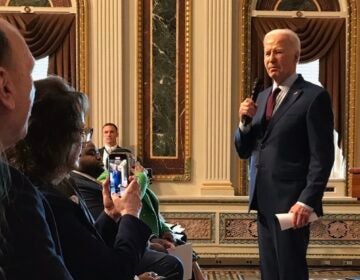Delaware’s progress on preparing for climate change
Listen
Icy water in the Delaware City Branch Canal. This area is one portion of the state that could be susceptible to sea-level rise. (Mark Eichmann/WHYY)
Delaware’s made progress in preparing for the impact of climate change, but there’s still more to do, according to the Climate Framework for Delaware.
Delaware’s greenhouse gas emissions decreased 29.7 percent from 2000 to 2010, the biggest drop of any state.
Solar energy capacity in the state is up 2,500 percent, from 2.3 MW to 59.8 MW in the past six years.
Energy use by state government is down nearly 13 percent since 2008.
– Climate Framework for Delaware
With the threat of sea level rise looming over the next century and Delaware’s vulnerable position on the coast, the state needs to become more resilient to climate change, according the framework report.
“We’ve got to continue to take action,” said Delaware Gov. Jack Markell.
Markell was joined by a number of cabinet secretaries and members of the environmental community for the presentation of the Climate Framework for Delaware. The report is the result of an Executive Order 41 that Markell signed in September 2013.
“I thought it was important for all of us to take a step back and think of all that’s been done over these last few years, as we also think about what we’re going to do in the future,” Markell said.
Front line Lewes
Obviously, the state’s beach areas are especially susceptible to the threat of sea level rise.
Lewes Mayor Ted Becker said town residents have had many recent reminders of the threat they face, from nor’easters to the recent brush with Superstorm Sandy. “It is that historical relationship that paved the way for Lewes to be better prepared for the future,” Becker said.
In 1999, Lewes was one of 200 towns nationwide to be named Project Impact community. That project got the ball rolling for town leaders to think about the long-term threat Lewes faces. “Those early steps led to a flood mitigation plan which was adopted in 2004 and a mitigation strategy that is managed and orchestrated by our mitigation planning team,” Becker said.
It’s that kind of planning and preparation municipalities and agencies in the state need to focus on in the years to come. “We view this as a living document,” DNREC Sec. David Small said of the framework. “There will be additional conversations and recommendations identified moving forward.”
The public can comment on the framework online through May 30 at de.gov/climateframework. A workshop for local government leaders and other stakeholders will be held next month in Dover.
——
You can find the Climate Framework in its entirety below:
WHYY is your source for fact-based, in-depth journalism and information. As a nonprofit organization, we rely on financial support from readers like you. Please give today.





